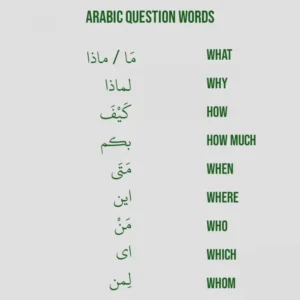Demonstrative Pronouns in Arabic With Examples (Ism Ishara)

In Arabic, demonstrative pronouns (اسم إشارة, ism ishaara) are used to indicate specific items in relation to the speaker. Demonstrative pronouns help make sentences less repetitive by replacing nouns with shorter words. This guide will show you how to use demonstrative pronouns in Arabic.
What Are Demonstrative Pronouns in Arabic?
Arabic demonstrative pronouns are words used to point out specific things or people. They show whether something is close to or far from the speaker.
- “This” refers to something near.
- “That” refers to something farther away.
- “These” are for multiple things or people that are near.
- “Those” are for multiple things or people that are farther away.
In Arabic, these pronouns change based on whether they are talking about something masculine or feminine, and whether they are singular or plural.
Here’s a table for Arabic demonstrative pronouns covering singular, dual, and plural forms:
| Form | Masculine | Feminine | Plural |
|---|---|---|---|
| Near | |||
| Singular | هذا (haadha) | هذه (haadhihi) | هؤلاء (haa’ulaa’i) |
| Dual | هذان (haadaan) | هاتان (haataan) | |
| Plural | هؤلاء (haa’ulaa’i) | هؤلاء (haa’ulaa’i) | |
| Far | |||
| Singular | ذاك (dhaak) | تلك (tilka) | |
| Dual | ذانك (dhaanik) | تانك (taanik) | |
| Plural | أولئك (ulaa’ika) | أولئك (ulaa’ika) | أولئك (ulaa’ika) |
- Near refers to something close to the speaker.
- Far refers to something farther away from the speaker.
- Dual is used when referring to exactly two items or people.
- Plural is used for more than two items or people.

Near Distance Arabic Demonstrative Pronouns
In Arabic, demonstrative pronouns for near distance are used to talk about things or people that are close to the speaker. Here’s a breakdown of each form:
Singular
- Masculine: هذا (haadha)
- Used to refer to a single masculine item that is close.
- Example: هذا قلم (haadha qalam) – This is a pen.
- Feminine: هذه (haadhihi)
- Used to refer to a single feminine item that is close.
- Example: هذه شجرة (haadhihi shajarah) – This is a tree.
Dual
- Masculine: هذان (haadaan)
- Used to refer to two masculine items that are close.
- Example: هذان كتابان (haadaan kitaabaan) – These are two books.
- Feminine: هاتان (haataan)
- Used to refer to two feminine items that are close.
- Example: هاتان مدرسيتان (haataan madrasaytaan) – These are two schools.
Plural
- Masculine and Feminine: هؤلاء (haa’ulaa’i)
- Used to refer to multiple items or people of any gender that are close.
- Example: هؤلاء طلاب (haa’ulaa’i tullab) – These are students.
These pronouns help specify and point out objects or people that are near to you in both singular, dual, and plural contexts.
Far Distance Arabic Demonstrative Pronouns
In Arabic, demonstrative pronouns for far distance are used to refer to things or people that are farther away from the speaker. Here’s a detailed look at each form:
Singular
- Masculine: ذاك (dhaak)
- Used to refer to a single masculine item that is far away.
- Example: ذاك قلم (dhaak qalam) – That is a pen.
- Feminine: تلك (tilka)
- Used to refer to a single feminine item that is far away.
- Example: تلك شجرة (tilka shajarah) – That is a tree.
Dual
- Masculine: ذانك (dhaanik)
- Used to refer to two masculine items that are far away.
- Example: ذانك كتابان (dhaanik kitaabaan) – Those are two books.
- Feminine: تانك (taanik)
- Used to refer to two feminine items that are far away.
- Example: تانك مدرستان (taanik madrasataan) – Those are two schools.
Plural
- Masculine and Feminine: أولئك (ulaa’ika)
- Used to refer to multiple items or people of any gender that are far away.
- Example: أولئك طلاب (ulaa’ika tullab) – Those are students.
These pronouns help identify and point out objects or people that are farther from you, whether you are talking about singular, dual, or plural items.
Masculine Demonstrative Pronouns In Arabic
Masculine demonstrative pronouns in Arabic are used to point out specific masculine items or people. Here’s a detailed look at each form:
Near Distance
- هذا (haadha)
- Usage: Refers to a single masculine item or person that is close to the speaker.
- Example: هذا كتاب (haadha kitaab) – This is a book.
Far Distance
- ذاك (dhaak)
- Usage: Refers to a single masculine item or person that is far away from the speaker.
- Example: ذاك قلم (dhaak qalam) – That is a pen.
Dual
- هذان (haadaan)
- Usage: Refers to two masculine items or people that are close to the speaker.
- Example: هذان كتابان (haadaan kitaabaan) – These are two books.
- ذانك (dhaanik)
- Usage: Refers to two masculine items or people that are far away from the speaker.
- Example: ذانك كتابان (dhaanik kitaabaan) – Those are two books.
Plural
- هؤلاء (haa’ulaa’i)
- Usage: Refers to multiple masculine items or people that are close to the speaker.
- Example: هؤلاء طلاب (haa’ulaa’i tullab) – These are students.
- أولئك (ulaa’ika)
- Usage: Refers to multiple masculine items or people that are far away from the speaker.
- Example: أولئك رجال (ulaa’ika rijaal) – Those are men.
These masculine demonstrative pronouns help specify and distinguish between items or people based on their proximity to the speaker.
Feminine Demonstrative Pronouns In Arabic
Sure! Here’s a detailed look at feminine demonstrative pronouns in Arabic:
Near Distance
- هذه (haadhihi)
- Usage: Refers to a single feminine item or person that is close to the speaker.
- Example: هذه مدرسة (haadhihi madrasah) – This is a school.
Far Distance
- تلك (tilka)
- Usage: Refers to a single feminine item or person that is far away from the speaker.
- Example: تلك شجرة (tilka shajarah) – That is a tree.
Dual
- هاتان (haataan)
- Usage: Refers to two feminine items or people that are close to the speaker.
- Example: هاتان مدرسيتان (haataan madrasaytaan) – These are two schools.
- تانك (taanik)
- Usage: Refers to two feminine items or people that are far away from the speaker.
- Example: تانك مدرسيتان (taanik madrasaytaan) – Those are two schools.
Plural
- هؤلاء (haa’ulaa’i)
- Usage: Refers to multiple feminine items or people that are close to the speaker.
- Example: هؤلاء طالبات (haa’ulaa’i taalibat) – These are female students.
- أولئك (ulaa’ika)
- Usage: Refers to multiple feminine items or people that are far away from the speaker.
- Example: أولئك فتيات (ulaa’ika fayaati) – Those are girls.
These feminine demonstrative pronouns help specify and point out items or people based on their gender and proximity to the speaker.
Pointing words in Arabic
Pointing words in Arabic include “this,” “that,” “here,” and “there.” To refer to a place, the demonstrative nouns هُنَا (hunaa), هُنَاكَ (hunaaka), and هُنَالِكَ (hunaalika) are used. هُنَا is for a near place, while هُنَاكَ and هُنَالِكَ refer to far places. The table below shows these pointing words in Arabic.
Pointing Words In Arabic (Near Distance)
| Gender | Singular | Dual | Plural |
| Male | هَذَا (this) | هَذَانِ (these) | هٰؤُلاءِ (these) |
| Female | هَذِهِ (this) | هَاتَانِ (these) | هٰؤُلاءِ (these) |
Pointing Words In Arabic (Far Distance)
| Gender | Singular | Dual | Plural |
| Male | ذٰلِكَ (that) | ذَانِكَ (those) | أُولٰئكَ (those) |
| Female | تِلكَ (that) | تَانِكَ (those) | أُولٰئكَ (those) |
Pointing Words In Arabic For Places
| Arabic | Transliteration | English |
| هنا | Hunaa | Here |
| هُناك | Hunaak | There |






